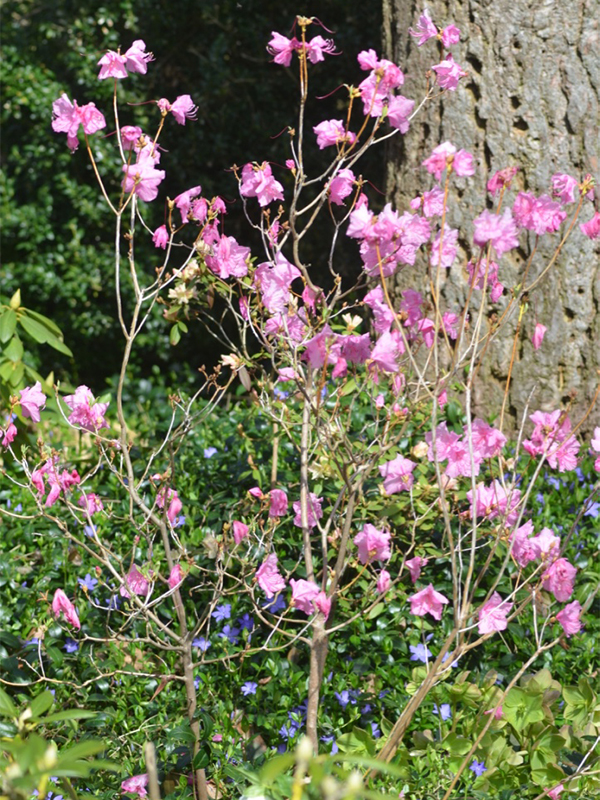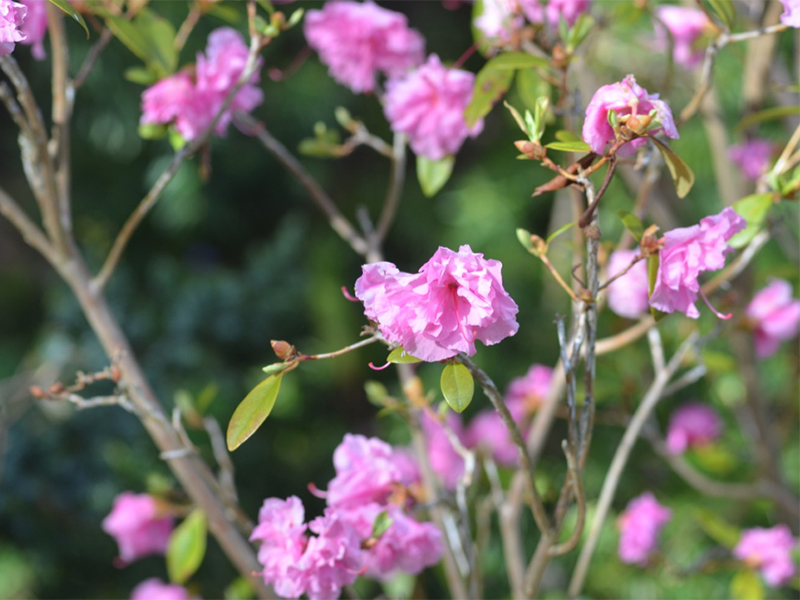
Woody > Rhododendron > Rhododendron mucronulatum > Rhododendron mucronulatum
Rhododendron mucronulatum
Korean Rhododendron, Korean Snow Azalea
Origin: R. mucronulatum is native to Northern China (Hebei, Jiangsu, Liaoning, Shandong), Mongolia, Korea and bordering areas of Russia (East Siberia) and Japan (Honshu, Kyushu). It was introduced into cultivation in 1837.
Mike's
Opinion


"
A semi-dwarf rhododendron that is quite attractive in bloom, pink enveloping the entire plant. Suited to a wide variety of landscape situations including mass plantings, shrub borders, foundation plantings and gardens where spring colour is needed. Several good cultivars are also available such as 'Craters Edge' a dwarf form to 1 m and 'Cornell Pink' an intense pink coloured plant.
Michael Pascoe, NDP., ODH., CLT., MSc. (Plant Conservation)
"
| Family |
| Ericaceae |
| Genus |
| Rhododendron |
| Species |
| mucronulatum |
| Category |
| Woody |
| Type |
| Tree (deciduous), Shrub (deciduous) |
| Pronunciation |
| USDA Hardiness Zone |
| 4a - 7 |
| Canadian Hardiness Zone |
| 6b |
| Temperature (°C) |
| -34 - 20 |
| Temperature (°F) |
| -36 - -7 |
| Height |
| 1 - 2 m |
| Spread |
| 1 - 2 m |
Photographs
Description and Growing Information
Flowering Period
| General Description |
| A plant to about 2 m, mucronate leaves and pink to purple to white blooms. It is one of the first Rhododendron species to flower in the spring, often before the snow fully melts. |
| Landscape |
| Used as a focal or accent point in landscape, planted in masses and groups as well as in shrub borders. Beautiful flower colour in the spring starting quite early. |
| Cultivation |
| Full shade or partial sun but will not tolerate intense summer heat. Moist, rich but well-drained acidic soils are a must. |
| Shape |
| Upright growth of many branches that form an oval shape, overall a compact plant. |
| Growth |
| Slow |
| Pests |
| Prone to winter injury and early possible early frost damage in the spring. Diseases include dieback, canker, crown rot, root rot, leaf spot, rust, and powdery mildew. The plant may also be affected by aphids, borers, lacebugs, leafhoppers, mealybugs, mites, nematodes, scale, thrips and whitefly and weevil. |
| Habitat |
| In Asia this species natural habitat is rocky, dryish slopes at elevations of 300-1700 m. In Betula or Larix forests and forest margins. |
| Bark/Stem Description |
| Bark is rough, and stems are often covered with tiny dots of yellow resin. |
| Flower/Leaf Bud Description |
| Medium sized buds that are rounded-ovid. |
| Leaf Description |
| R. mucronulatum has green, sharp pointed (Mucronate), alternate leaves to 3–7 x 1–3.5 cm. The leaf blade is thin, elliptic or elliptic-lanceolate with the leaf base cuneate or obtuse. The leaf margin is entire or denticulate with the leaf apex acute, acuminate or obtuse. The abaxial leaf surface is brown and scaly while the adaxial leaf surface is sparsely scaly. The petiole is 3–5 mm in length. Leaves are produced after flowering in the spring and are shed in the autumn after they turn yellow/brown to red-scarlet. When the foliage is bruised a slight fragrance is released. |
| Flower Description |
| Inflorescences are 1- 3, subapical, pseudoumbellate with persistent bud scales. The pedicel 0.5–1 cm in length and sparsely scaly. The calyx is 5-lobed, scaly, glaborous or sparsely setose, 0.5–1 mm. The corolla is funnelform, 2.3–2.8 x 3–4 cm with the outer surface being pubescent. There are 10 stamens, unequal in length and being slightly shorter than the corolla tube. The filaments are pubescent below while the ovary is 5-locular and densely scaly. The style is longer than than the corolla and is glabrous. The widely, funnel-shaped, flowers are typically rosy-purple in colour, but can be pink, white and even mottled combinations thereof. They open successively from clusters of buds at the end of the shoots before the leaves expand, hence the name Korean Snow Azalea often flowering before the snow melts. While they can be killed by frosts below -5°C, damaged blooms are soon replaced by new ones. |
| Fruit Description |
| Small cylindric fruit capsules (brown) 10-15 mm long and 4-5 mm around. |
| Colour Description |
| White/pink flower with green leaves that turn a yellow to red colour in the autumn. |
| Texture Description |
| A medium to fine textured plant, however in winter its form is rather coarse. |
| Notable Specimens |
| The Niagara Parks Botanical Gardens and School of Horticulture, Niagara Falls, Ontario, Canada. |
| Propagation |
| Seeding is often the best method, sow in pots in a greenhouse and do not allow the medium to dry out, grow on for at least one winter in the greenhouse before moving them to the nursery. Layering in late July may also be effective however it may take up to 24 months for the layers to root adequately. Cuttings of half-ripe wood taken in August may have moderate success. |

